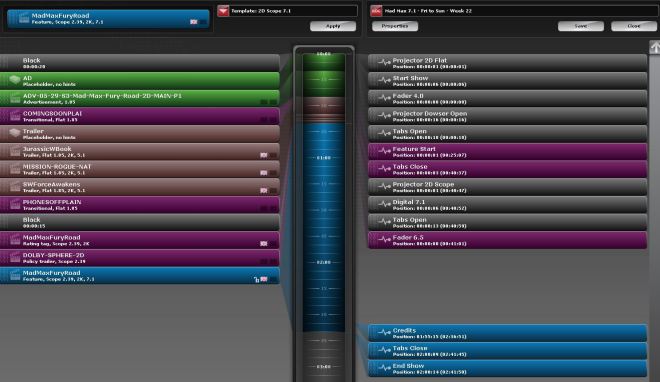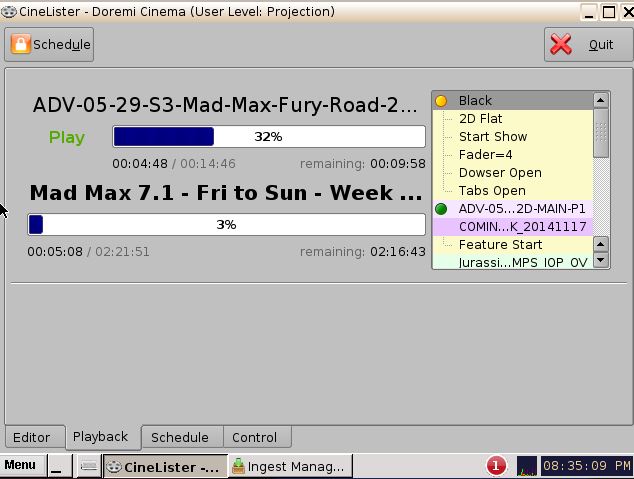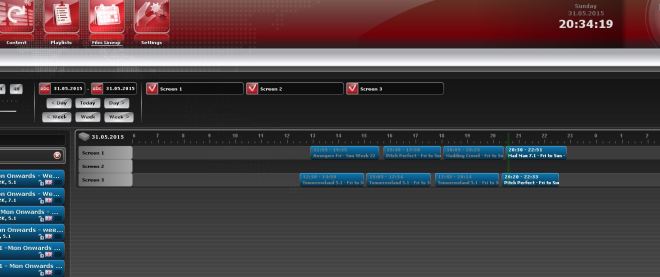It’s impossible to overstate what a seismic technical change has gone on behind the scenes in the last few years. Out went the physical medium of film, in came the ones and zeros of digital picture technology. It’s a change on a par with the coming of sound in the late 20’s, and if you didn’t keep up and invest, you’d be left horribly behind.
Of course, some people held out longer than others. They are probably the ones still on the fence about whether they should get a website or not.
Inevitably though, and after long arguments about who was going to pay for it and horror stories about distributors controlling what screen their film is in and the performance times (which actually they could do, but have so far resisted) everyone has now gone digital.
Or more accurately DLP, data light processing. We use projectors capable of a maximum 2K resolution or 2048 x 1080. There are 4K projectors, with 4096 x 2160 resolution.
Now beware here, because although a lot of multiplexes are fond of telling you they have the latest 4K resolution technology and indeed they have 4K capable projectors, that doesn’t mean you are seeing a 4K picture. The vast majority of releases are 2K, with only a handful a year in 4K.
Obfuscation really is one of my least favourite things in the world, that and red cabbage.
Anyhoo. Are you still with me? Have you glazed over yet? I just wanted to give you a broad idea of what has replaced film in a practical sense. So here goes.
Instead of a pile of heavy old cans, the film now arrives either on a physical hard drive, like the ones in your computer, or increasingly down the broadband lines coming into our servers.
Either way, that collection of data is called a DCP. If you want an in depth look inside the exciting world of the DCP click here. The DCP contains all the sound and picture information, and once delivered to us we have to get that information onto our projectors.
Here’s a handsome young man to show you how.
So once that film is “ingested” as we say it just requires a KDM or key to unlock it as it won’t play without one. The KDM is a digital file that tells the projector and server that it’s allowed to play that film.
KDM’s are the pointless work of the devil and whoever invented them should be summarily executed. But as the kids so often say these days, let’s not go there right now.
They come separately from the feature and once loaded on the server they enable the film to play. But there is a lot more to do before we let you guys see it. We need to add adverts, trailers and automation queues.
I love automation, after five years of it I’m still staggered when the lights go down and the curtains open, ALL BY THEMSELVES!
So here is a playlist:
We create the playlist on an incredible bit of software that controls all the projectors from a central point. It’s called a TMS. Theatre Management System, it’s fantastic. It means I can sit at my desk all day like Baron Greenback overlooking the technical marvel I have created with only £160,000. Did I mention this stuff is expensive?
On the left are the elements, adverts, coming soon snipes,trailers and the feature. The black is to be able to use queues with no picture on the screen. On the right are the queues, so you can see start show, tabs close etc. The zero point is the start and you can see that the performance ends 2hrs 41 minutes and 50 seconds after the start. Lovely.
Here you can see the playlist playing on the Doremi server attached to the projector:
We have to make a playlist for each film playing that week and then add them to a timeline on the TMS. This then disseminates content and playlists to the designated projector.
It’s witchery plain and simple.
Here is today’s films on the time line:
And that’s it, we arrive in the morning and fire up the projectors and the TMS and the automation does the rest for the whole day.
Now, the technology is wonderful, but still a wee bit flaky. Sometimes queues don’t fire leaving us with picture and no sound say. Which is why I believe to maintain standards having technical people on the building is a must. Sadly most circuits have got rid of all their projectionists, running everything from a central hub. I guess they have worked out it’s cheaper to lose a show or two here and there and give refunds rather than pay someone who knows what they are doing to run the box properly.
Ok, did you get all that?
Any questions?





Thanks for that explanation, I have occasionally, if the film was flagging a bit wondered what was going on – I realise it the days of Cinema Paradiso are long gone. Love the refurb by the way.
Thanks for the exposé on the latest in the digital world, Kevin. I’m not much the wiser, but that’s not due to your lucid and ordered explanation, more to my total inability to get to grips with the ever-faster evolving technical world. Rather like driving a car: not a clue what’s going on under the bonnet, but happy it doesn’t break down and leave me stranded. I’ll just continue to enjoy your great choice of film knowing that those in charge are completely au fait with how to give me a great experience. Thanks for trying to educate us and I hope those who do understand will appreciate it.